Back to: Robotics & Artificial Intelligence (Class X)
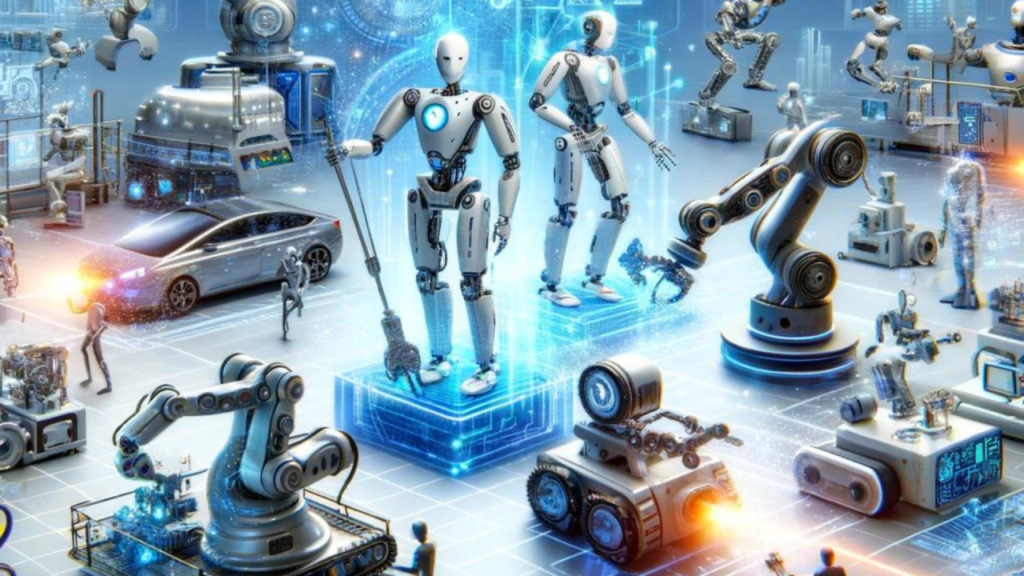
Warehouse Robot
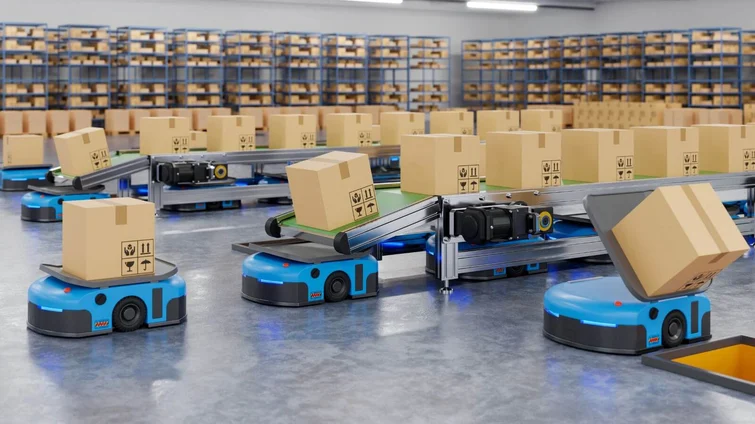
A warehouse robot is an automated machine designed to handle tasks within a warehouse setting, such as moving goods, sorting items, managing inventory, and even packing orders. These robots streamline operations, increase efficiency, and reduce the need for heavy manual labor. Common types of warehouse robots include:
- Automated Guided Vehicles (AGVs): These robots follow predefined paths to transport goods across the warehouse.
- Autonomous Mobile Robots (AMRs): More advanced than AGVs, AMRs navigate warehouses independently using sensors and cameras.
- Sorting Robots: These robots categorize products by sorting them according to specific criteria and preparing them for packaging or shipping.
- Picking and Packing Robots: Equipped with arms and grippers, these robots pick items from shelves and pack them as per orders.
- Storage and Retrieval Robots: These systems help in placing items in their correct storage locations and retrieving them as needed.
Warehouse robots are widely used in e-commerce and logistics, where high efficiency and quick order fulfillment are crucial.
Life Cycle
The work cycle of a warehouse robot typically involves several key steps to complete tasks efficiently within a warehouse environment. Here’s a breakdown of the general work cycle:
Task Assignment and Navigation
The warehouse management system (WMS) assigns a specific task to the robot, such as retrieving, sorting, or transporting items. The robot uses pre-programmed routes, sensors, or mapping algorithms to navigate its way to the specified location within the warehouse.
Object Detection and Item Identification
Upon reaching the designated area, the robot’s sensors (e.g., cameras, laser sensors, or RFID) help it detect and identify the correct item. For picking robots, this involves locating and recognizing the item on a shelf or bin.
Item Picking or Transporting
Depending on the robot’s function, it either picks up the item with a robotic arm or loads it onto itself if it’s a transport robot. For packing robots, this may involve scanning and confirming the item before adding it to the order.
Transporting the Item to the Destination
Once the item is secured, the robot navigates through the warehouse, moving the item to a specified location, such as a packing station, delivery dock, or another storage area. Autonomous robots often adjust their paths in real-time to avoid obstacles and other robots or workers in the warehouse.
Placement or Delivery
The robot places the item at the destination point as per instructions from the WMS. For sorting robots, this might mean adding the item to a designated bin; for transport robots, it could mean docking at a packing station.
Return to Start or Idle Position
After completing the task, the robot either returns to a home or charging station or moves to a designated idle area while awaiting the next task. If the battery is low, the robot may autonomously navigate to a charging dock.
Cycle Repeat
The process repeats as the robot receives new tasks from the WMS or task manager.
This work cycle enables warehouse robots to improve operational efficiency, reduce manual labor, and minimize errors in high-paced environments.
Assistant Robot
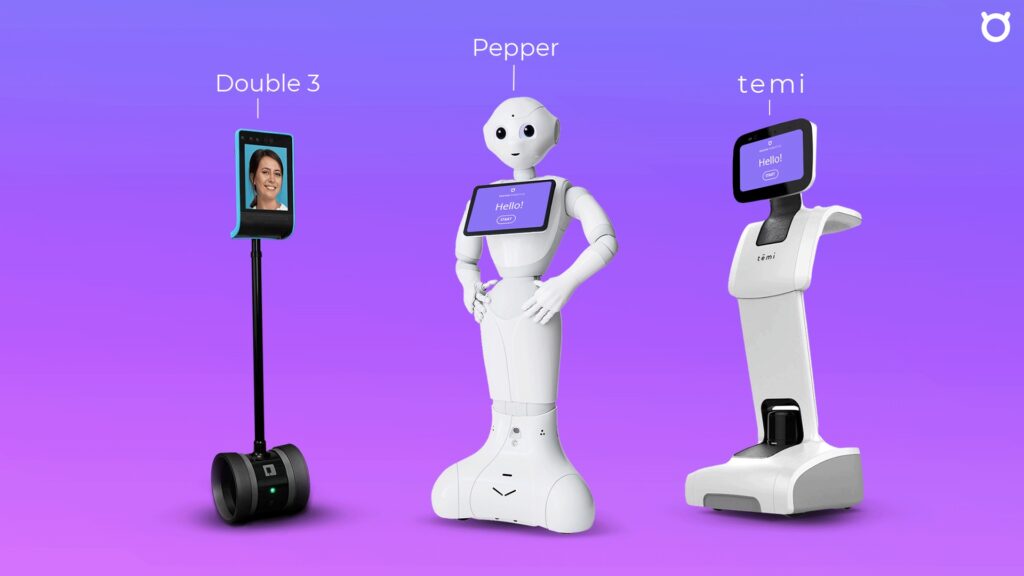
What are Assistant Robots?
Assistant robots are machines designed to help people with different tasks. They can work in homes, hospitals, offices, and factories. These robots make work easier and save time.
Types of Assistant Robots
- Home Assistant Robots
- Help with cleaning, like Roomba, a robotic vacuum cleaner.
- Control smart home devices, like Amazon Astro, which manages lights and security.
- Healthcare Assistant Robots
- Help doctors in surgeries, like the Da Vinci Surgical Robot.
- Assist elderly or disabled people, like Robear, which helps lift patients.
- Customer Service Robots
- Answer questions in malls, banks, and hotels, like Pepper Robot.
- Help travelers in airports, like Spencer Robot.
- Industrial Assistant Robots
- Work with humans in factories, called Cobots (Collaborative Robots).
- Help in assembling products and carrying materials.
Features of Assistant Robots
- Artificial Intelligence (AI): Understands and responds to commands.
- Sensors & Cameras: Detect objects and recognize faces.
- Connectivity: Connects to Wi-Fi and smart devices.
- Voice Recognition: Understands spoken instructions, like Alexa-powered robots.
Benefits of Assistant Robots
✅ Help in daily tasks, saving time and effort.
✅ Improve safety by handling risky jobs.
✅ Work 24/7 without getting tired.
✅ Support elderly and disabled people in their daily activities.
Challenges of Assistant Robots
❌ Expensive to buy and maintain.
❌ Depend on technology and the internet.
❌ May replace some human jobs.
Future of Assistant Robots
In the future, assistant robots will become smarter and more helpful. They will improve human lives by handling even more tasks.
Smart Home

Smart homes are residences equipped with internet-connected devices that enable remote monitoring, management, and automation of household systems, such as lighting, heating, security, and entertainment. These devices communicate via the Internet of Things (IoT), creating a seamless environment where various systems work together to enhance convenience, energy efficiency, security, and overall quality of life.
Key Features of Smart Homes:
Automation and Control
- Homeowners can automate tasks like adjusting lighting, controlling temperatures, or even setting up routines (e.g., lights turning on at sunset).
- Most smart home systems allow remote control via smartphone apps, enabling users to manage settings from anywhere.
Energy Efficiency
- Smart thermostats and lighting systems learn user habits and adjust themselves to conserve energy, lowering utility costs.
- Appliances can be scheduled to operate during off-peak hours to save energy.
Home Security
- Smart security systems include cameras, motion detectors, door/window sensors, and smart locks, allowing real-time monitoring.
- Many systems provide alerts directly to a user’s phone in case of unusual activity, increasing safety.
Voice Assistance Integration
- Devices like Amazon Alexa, Google Assistant, or Apple HomeKit can control compatible devices through voice commands, making daily tasks easier and more accessible.
Health and Wellness Monitoring
- Smart homes can integrate devices that track air quality, water quality, and even sleep patterns, contributing to healthier living environments.
Examples of Smart Home Devices
Smart Thermostats (e.g., Nest, Ecobee) that adjust heating and cooling based on occupancy and preferences.
Smart Lights (e.g., Philips Hue) that can change color, dim, or turn off based on the time of day or mood.
Smart Security Cameras (e.g., Ring, Arlo) that enable real-time surveillance.
Smart Appliances (e.g., smart refrigerators, washing machines) that can be controlled remotely or scheduled for specific tasks.
Voice-Activated Assistants like Amazon Echo or Google Nest, which integrate with other smart devices for hands-free control.
Benefits of Smart Homes
Convenience through automated tasks and centralized control.
Energy Savings with systems designed to optimize energy use.
Enhanced Security with 24/7 monitoring and alerts.
Personalization with devices that adapt to individual preferences and routines.
Smart School

Smart schools use advanced digital technologies to create an engaging, interactive, and efficient learning environment for students, educators, and administrators. Through tools like interactive displays, online platforms, and smart classroom management systems, smart schools aim to enhance the educational experience, improve accessibility, and foster collaboration.
Key Features of Smart Schools
Digital Classrooms
- Interactive whiteboards, tablets, and projectors replace traditional teaching aids, making lessons more dynamic and visually engaging.
- Online resources and digital curricula are accessible from various devices, allowing students to learn beyond textbooks.
Learning Management Systems (LMS)
- LMS platforms enable teachers to share assignments, track student progress, provide feedback, and manage grading.
- Students can access study materials, submit assignments, and monitor their performance through a centralized platform.
Personalized Learning
- Adaptive learning software tailors lessons based on each student’s learning pace, strengths, and weaknesses.
- Teachers can provide targeted support through data-driven insights, making learning more effective and individualized.
Remote and Blended Learning Options
- Smart schools support both in-person and online learning, enabling flexibility in attending classes from anywhere.
- Video conferencing tools, virtual classrooms, and collaboration platforms allow for hybrid learning environments.
IoT and Smart Devices
- IoT sensors monitor lighting, temperature, and air quality in classrooms, creating a comfortable and energy-efficient environment.
- Smart attendance systems use biometrics or RFID to streamline attendance tracking.
Enhanced Communication
- Messaging apps, emails, and portals keep parents informed about their child’s progress, school events, and other updates.
- Teachers and administrators can quickly communicate with parents and students, ensuring a transparent flow of information.
Examples of Smart School Technology
Interactive Whiteboards for hands-on activities and visual explanations.
Tablets and Laptops for digital note-taking, online research, and access to interactive learning apps.
Educational Apps like Google Classroom, Microsoft Teams, or Kahoot! that support quizzes, assignments, and discussions.
Cloud-Based Platforms for easy access to resources, collaboration, and storage of educational materials.
Student Information Systems (SIS) for tracking academic records, attendance, and grades.
Benefits of Smart Schools
Enhanced Learning Experience with interactive and multimedia-based lessons.
Personalized Education catering to different learning styles and abilities.
Improved Efficiency in administrative tasks like grading, attendance, and resource allocation.
Greater Accessibility through digital resources available at any time and place.
Environmentally Friendly as digital resources reduce the need for paper and physical supplies.
Smart Mobility
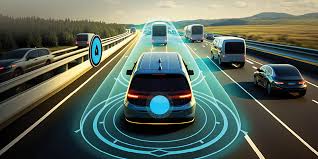
Smart mobility refers to the use of advanced technologies and data-driven solutions to improve the efficiency, accessibility, safety, and sustainability of transportation systems. This concept integrates electric vehicles, autonomous vehicles, ride-sharing services, real-time data, and urban infrastructure, aiming to address urban congestion, reduce pollution, and create seamless, accessible transportation for everyone.
Key Components of Smart Mobility
Electric Vehicles (EVs) and Charging Infrastructure
- The rise of EVs reduces emissions and dependence on fossil fuels.
- Smart charging stations, often integrated with renewable energy sources, provide convenient access for EVs, allowing users to locate, reserve, and monitor charging stations via mobile apps.
Autonomous and Connected Vehicles
- Self-driving vehicles use sensors, cameras, and artificial intelligence to navigate roads without human input, promising safer, efficient travel.
- Connected vehicles communicate with each other and with infrastructure to avoid accidents, optimize traffic flow, and share real-time data.
Shared Mobility Services
- Ride-sharing, car-sharing, and bike-sharing services reduce the need for private car ownership, offering flexible and cost-effective alternatives.
- These services also optimize resource usage by reducing the number of vehicles on the road, lowering emissions, and reducing congestion.
Real-Time Traffic and Navigation Systems
- Traffic management systems collect and analyze data from vehicles, infrastructure, and sensors to optimize traffic flow.
- Navigation apps use real-time data to provide route recommendations, congestion alerts, and alternative paths, allowing commuters to make better travel decisions.
Urban Infrastructure and Smart Roads
- Smart roads include sensors, cameras, and wireless connectivity to monitor traffic, road conditions, and weather.
- Some smart road systems dynamically adjust traffic lights and signals based on traffic volume to prevent bottlenecks.
Micromobility Solutions
- Electric scooters, bikes, and other small vehicles provide short-distance travel options, especially in urban areas, reducing car usage and contributing to a greener transportation ecosystem.
Data Analytics and AI for Predictive Maintenance
- IoT sensors in vehicles and infrastructure gather data on performance, enabling predictive maintenance and reducing breakdowns.
- Data analytics identify usage patterns, helping cities and companies make data-informed decisions to improve public transport systems.
Benefits of Smart Mobility
Reduced Traffic Congestion through efficient route planning and vehicle sharing.
Lower Carbon Emissions by promoting EVs and reducing individual car use.
Enhanced Safety with autonomous driving and connected vehicles to prevent accidents.
Greater Accessibility providing flexible travel options that cater to diverse needs, including those without access to private vehicles.
Cost Savings for individuals and municipalities through shared mobility and infrastructure efficiency.
Autonomous Car

An autonomous car, also known as a self-driving car, is a vehicle capable of navigating and operating without direct human input by using a combination of sensors, cameras, artificial intelligence (AI), and advanced algorithms. These cars are designed to analyze their surroundings, make decisions, and drive themselves safely, potentially revolutionizing transportation by enhancing road safety, reducing traffic congestion, and increasing mobility accessibility.
Key Components of an Autonomous Car
- Sensors and Cameras
- Radar Sensors monitor the distance to other vehicles and obstacles.
- Lidar Sensors use laser pulses to create detailed 3D maps of the car’s surroundings.
- Cameras provide real-time images to detect lane markings, traffic signals, pedestrians, and other vehicles.
- Artificial Intelligence and Machine Learning
- AI algorithms process data from sensors, enabling the car to recognize objects, predict movements, and make real-time decisions.
- Machine learning enables the car to learn from previous trips and improve over time, making navigation smoother and safer.
- Control Systems
- Steering, braking, and throttle systems are connected to the central processor, which controls these functions autonomously.
- Control systems ensure the vehicle responds accurately to commands based on sensor input, ensuring safe driving.
- GPS and Mapping Systems
- GPS provides location data, while mapping systems help the car understand its environment and navigate efficiently.
- High-definition maps offer details like road signs, lane boundaries, and curvature, enhancing the car’s awareness of its environment.
- Connectivity and Communication
- Vehicle-to-Everything (V2X) technology allows cars to communicate with other vehicles, infrastructure, and even pedestrians.
- This connectivity helps the car receive real-time traffic updates, weather conditions, and warnings about hazards on the road.
Levels of Autonomy (SAE Levels)
Level 0: No automation; the driver controls everything.
Level 1: Driver assistance, with features like adaptive cruise control and lane keeping.
Level 2: Partial automation, where the car can handle both steering and speed control but requires human monitoring.
Level 3: Conditional automation, allowing the car to operate autonomously under certain conditions, with the driver ready to take over.
Level 4: High automation, where the car can drive itself in most conditions without human intervention but may require a driver in specific situations.
Level 5: Full automation, where the car can handle all driving tasks independently in any condition and does not require a human driver.
Benefits of Autonomous Cars
Enhanced Safety by reducing human error, which causes the majority of accidents.
Increased Accessibility for those unable to drive, such as elderly or disabled individuals.
Reduced Traffic Congestion through optimized routing and smooth traffic flow.
Lower Emissions by encouraging efficient driving and supporting electric vehicle integration.
Challenges of Autonomous Cars
Complexity of Urban Environments with unpredictable pedestrians, cyclists, and complex road layouts.
Weather Sensitivity where rain, snow, and fog can obstruct sensors and cameras.
Ethical and Legal Issues around decision-making in unavoidable accidents and liability concerns.
High Costs associated with the technology and maintenance of autonomous systems.
Autonomous Drone

What is an Autonomous Drone?
An autonomous drone is a flying robot that can work on its own without a person controlling it. It uses Artificial Intelligence (AI), sensors, GPS, and cameras to move and complete tasks.
How Do Autonomous Drones Work?
- Sensors & Cameras: Help the drone see obstacles and take pictures or videos.
- GPS & Navigation: Helps the drone know its location and find its way.
- AI & Smart Systems: Help the drone make decisions and fly safely.
- Battery & Motors: Give power and control movement.
Where Are Autonomous Drones Used?
- Delivery Services
- Companies like Amazon Prime Air use drones to deliver packages.
- Farming & Agriculture
- Drones help farmers by spraying fertilizers and checking crops.
- Disaster Rescue
- Used to find missing people and help during floods or fires.
- Military & Security
- Used for spying, border security, and tracking dangers.
- Photography & Filming
- Used in movies, sports events, and news reports.
Benefits of Autonomous Drones
✅ Work without a person controlling them.
✅ Can go to dangerous places safely.
✅ Complete tasks quickly and save time.
✅ Reduce risk to human life.
Challenges of Autonomous Drones
❌ Expensive to build and use.
❌ Can invade people’s privacy.
❌ Short battery life.
❌ Need smart AI to avoid crashes.
Future of Autonomous Drones
Drones will become smarter, safer, and more useful in the future. They will help in medicine, construction, space research, and more.
Robotics for Medicine and Healthcare
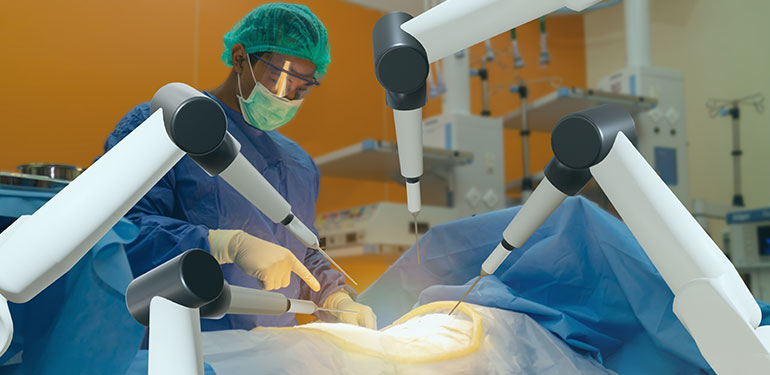
What Are Medical Robots?
Medical robots are special machines that help doctors, nurses, and patients in hospitals. They assist in surgeries, patient care, and even delivering medicines.
Types of Medical Robots
- Surgical Robots
- Help doctors perform operations with great accuracy.
- Example: Da Vinci Surgical Robot is used in complex surgeries.
- Rehabilitation Robots
- Help injured or disabled people recover faster.
- Example: EksoGT, a robotic suit that helps people walk again.
- Caregiving Robots
- Assist elderly or disabled people with daily activities.
- Example: Robear, a robot that lifts and moves patients.
- Hospital Service Robots
- Carry medicines, food, and medical tools inside hospitals.
- Example: TUG Robot, which transports supplies.
- Cleaning & Disinfection Robots
- Kill germs in hospital rooms using UV light or disinfectants.
- Example: Xenex Robot, which helps keep hospitals clean.
Benefits of Medical Robots
✅ Perform surgeries with great care and accuracy.
✅ Reduce the workload of doctors and nurses.
✅ Help patients recover faster.
✅ Provide 24/7 support to patients.
✅ Keep hospitals clean and prevent infections.
Challenges of Medical Robots
❌ Very expensive to buy and maintain.
❌ Need trained professionals to use them.
❌ Depend on electricity and internet.
❌ Some people worry they may replace human caregivers.
Future of Robots in Healthcare
In the future, medical robots will be smarter, more affordable, and more useful. They will help in remote surgeries, faster treatments, and better patient care.
NARS (Non-Axiomatic Reasoning Systems)
Ability to handle uncertainty at the time of decision making
NARS stands for Non-Axiomatic Reasoning System. It’s an artificial intelligence framework developed by Pei Wang. NARS aims to mimic human-like reasoning by incorporating aspects like uncertainty, learning, and adaptation. Unlike traditional logic-based systems that rely heavily on fixed rules and axioms, NARS is more flexible, allowing it to handle incomplete information and change. It’s designed to learn from its experiences, making it suitable for complex problem-solving tasks where uncertainty is present. NARS has applications in various domains, including natural language understanding, robotics, and decision-making systems.
Natural Language Understanding: NARS could be used to develop systems that understand and generate natural language.
Robotics: NARS could be integrated into robotic systems to enable them to reason about their environment, make decisions, and adapt to changing conditions.
Diagnosis and Decision Support: NARS could be used in medical diagnosis systems or decision support tools. It could analyse patient data, medical records, and symptoms to assist healthcare professionals in diagnosing illnesses, recommending treatments, and predicting outcomes.
Autonomous Vehicles: NARS could be applied in the development of autonomous vehicles to enhance their decision-making capabilities.
